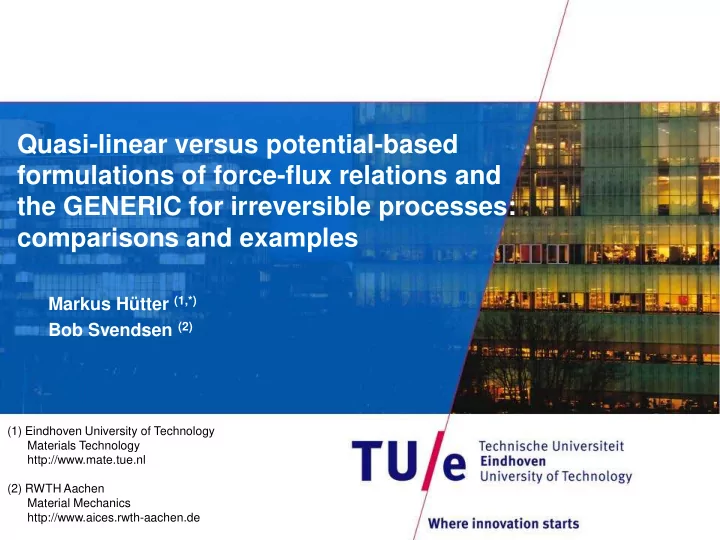

Quasi-linear versus potential-based formulations of force-flux relations and the GENERIC for irreversible processes: comparisons and examples Markus Hütter (1,*) Bob Svendsen (2) (1) Eindhoven University of Technology Materials Technology http://www.mate.tue.nl (2) RWTH Aachen Material Mechanics http://www.aices.rwth-aachen.de
irreversible dynamics • relations between forces and fluxes (e.g. …) • (quasi-)linear relations [1,2] • perturbation theory • fluctuation-dissipation theorem • dissipation potential [3] [1] de Groot, Mazur, 1962. Non-equilibrium Thermodynamics. [2] Lifshitz, Pitaevskii, 1981. Physical Kinetics. Vol. 10, Landau and Lifshitz Series on Theoretical Physics. 10-10-2012 Page 1 [3] Šilhavý, 1997. The Mechanics and Thermodynamics of Continuous Media.
motivation Hans Christian Öttinger • Fluid mechanics (hydrodyn.; fluctuating hydrodyn.) • transport processes (thermal, diffusion, electric, thermophoretic, …) • relativistic hydrodynamics (special and general relativity) • Kinetic theory of gases • Suspensions Theo Tervoort • two-phase flow, LCPs • crystallization (flow-induced) • Solid mechanics • elasticity, viscoplasticity, anisotropic yielding • damage mechanics Han Meijer Marc Geers • dislocation reactions • Complex fluids with structural variables (tensor, distr. fct.) • dumbbell • reptation • pompom, XPP • Modeling Bob Svendsen • coarse graining, multi-scale simulations • mean-field approximations 10-10-2012 Page 2
comparison • entropy production (2 nd law) • quasi-linear relations • is irrelevant • 10-10-2012 Page 3
comparison • entropy production (2 nd law) • dissipation potential • positivity and convexity 10-10-2012 Page 4
close to equilibrium: linear response • entropy production (2 nd law) • linear relation • dissipation potential 10-10-2012 Page 5
general ? • → • construction of • close to equilibrium : • general: 10-10-2012 Page 6
general ? • → • counter example (1): conflict with convexity 10-10-2012 Page 7
general ? • → • counter example (2): non-dissipative irreversible dynamics → → • slip (Schowalter derivative) [1,2,3] [1] Wapperom, Hulsen, J. Rheol. 42, 999, 1998. [2] Dressler et al., Rheol. Acta 38, 117, 1999. 10-10-2012 Page 8 [3] Öttinger, Beyond Equilibrium Thermodynamics, 2005.
general ? • → • counter example (3) [condition] [1] Wapperom, Hulsen, J. Rheol. 42, 999, 1998. [2] Dressler et al., Rheol. Acta 38, 117, 1999. 10-10-2012 Page 9 [3] Öttinger, Beyond Equilibrium Thermodynamics, 2005.
more elegant procedure • generalization of Helmholtz theorem with if j , f is symmetric; especially: j = φ , f • one can show [1] Edelen, 1973 [2] Edelen, 1986 10-10-2012 Page 10 [3] Šilhavý, 1997, Ch. 12.
more elegant procedure • generalization of Helmholtz theorem with • quasi-linear relation (2) (2) (1) [1] Edelen, 1973 [2] Edelen, 1986 10-10-2012 Page 11 [3] Šilhavý, 1997, Ch. 12.
GENERIC reversible irreversible G eneral E quation for the N on- E quilibrium R eversible- Poisson friction I rreversible operator matrix C oupling Grmela, Öttinger, PRE 56 (1997), 6620. Öttinger, Grmela, PRE 56 (1997), 6633. 10-10-2012 Page 12 Öttinger, Beyond Equilibrium Thermodynamics, 2005.
GENERIC • quasi-linear form • dissipation-potential representation Grmela, Öttinger, PRE 56 (1997), 6620. Öttinger, Grmela, PRE 56 (1997), 6633. 10-10-2012 Page 13 Öttinger, Beyond Equilibrium Thermodynamics, 2005.
GENERIC • mapping between GENERIC and force-flux relations relation between force and entropy derivative with independent of entropy production: → quasi-linear form: → Edwards, 1998. 10-10-2012 Page 14 Öttinger, Beyond Equilibrium Thermodynamics, 2005.
GENERIC • mapping between GENERIC and force-flux relations relation between force and entropy derivative with independent of entropy production: → dissipation-potential form: → Edwards, 1998. 10-10-2012 Page 15 Öttinger, Beyond Equilibrium Thermodynamics, 2005.
coarse graining: projection operators reversible (N. B. Wecando) slow irreversible fluctuations fast separation of time scales Öttinger, PRE, 1998. Öttinger, Beyond Equilibrium Thermodynamics, 2005.
example 1: heat conduction • forces and fluxes • possible potential-representation 1. 2. 3. 10-10-2012 Page 17
example 2: chemical reaction(s) • forces and fluxes • possible potential-representation 1. here: 2. Grmela (2010) 10-10-2012 Page 18
summary • relations between forces and fluxes (e.g. …) • (quasi-)linear relations [1,2] • perturbation theory • fluctuation-dissipation theorem • dissipation potential [3] 10-10-2012 Page 19 Hütter, Svendsen, manuscript submitted to Contin. Mech. Thermodyn., 2012.
Recommend
More recommend